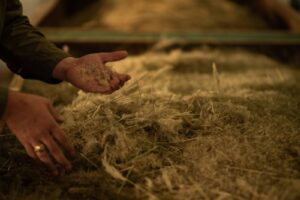By Rob Cook, Director of Business Development, Bamert Seed
Every so often we hear about the next silver bullet that will solve all of our problems. Someone is touting the next grass to solve all of our grazing and reclamation needs or the next species of pollinators that will bring back all of the butterflies. Usually we end up planting these species in monocultures. A monoculture is defined as the cultivation or growth of a single crop or organism. In the case of grasses, these monocultures are more often than not introduced species. What we always seem to find out is that these silver bullets are just another tool in our toolbox, and will not allow us to overcome improper management. In fact, many times these tools become a hindrance to the long term goals of our project because we rely on them too heavily or use them out of place. Proper management and biodiversity are the keys to meeting our long term goals. In fact, there are three good reasons not to use monocultures.
#1. The Cost of Inputs
Mother Nature hates a monoculture. A large chunk of the inputs and energy used to manage a monoculture come in trying to keep it that way. Whether in a crop production or a pasture setting, weed management is a key input. A weed can be defined as a plant out of place. In a monoculture such as tall fescue, a weed is any plant besides tall fescue. Whether tillage or herbicides are used to control these weeds, there is an added cost. In a system that uses the benefits of biodiversity, these “weeds” actually have a place after the stand is established. Many, but not all, of these “weeds” have benefits. Because they have benefits, we stop seeing them as out of place plants and start referring to them as forbs and legumes. In fact, many forbs and legumes have higher nutrient value than the grasses we usually consider to be the optimal forage. They also provide pollinator and wildlife habitat. Legumes will fix nitrogen from the atmosphere. Many of the introduced forage species that are planted as monocultures only produce favorable forage production with the added input of fertilization, which also adds to the cost of production. Of course, a diverse stand of native grass is not a silver bullet either. Grazing and haying must be managed correctly to avoid invasion by unwanted forbs and brush.
#2. Invasive Plants
Many of the introduced grasses that are planted in monocultures can be considered a weed in many settings. Some have a tendency to invade into areas where they are not wanted. They can invade across large parts of our landscape and significantly reduce biodiversity and impact wildlife and pollinator habitat. Operations change and the needs and demands from forage change with them. Land managers are starting to understand the benefits of biodiversity. Once established these monoculture pastures can be very difficult and expensive to convert back into a diverse native pasture that requires fewer inputs and provides many other benefits.
#3. The Benefits of Biodiversity
A diverse mix of grasses, forbs, and legumes in a rangeland, pasture, or cropland situation provides several benefits. The diversity in plant life will attract a diversity of insects and wildlife. Many of these will be beneficials that will prey on the pest species found in our production systems. This could lead to a decrease in inputs. The diversity above ground will lead to a diversity below ground. The root systems of the plants will vary in shape, depth, and in their impact on the soil. These roots will draw nutrients and moisture from different areas of the soil profile during different times of the year based on each individual species’ growth curve. This diversity gives us our best shot at drought tolerance. A monoculture in any setting is taking water and nutrients from the same area of the soil profile at the same time. This results in higher competition among plants and will result in fewer available resources. Monocultures, especially perennial monocultures, do not allow for any flexibility. A pasture or right-of-way with a diverse mix of species will have plants with many different growth curves and will have wildlife habitat, pollinator habitat, or grazing throughout all or most of the year. A cropland field, with at the very least a diverse crop rotation, will allow for the capture of most of the same benefits. We know for certain they are not making any more land, and removing the flexibility to meet market demands or climatic conditions by being stuck in a single season of use because of a monoculture makes that particular land more expensive to operate.
Large parts of many states have been planted to monocultures, and there will continue to be monocultures that are managed for crop and forage production. Hopefully more and more of these will be managed in a system that includes pastures and fields that have biodiversity. When we have the opportunity to establish perennial vegetation, these three reasons should help us to understand the importance of biodiversity.



